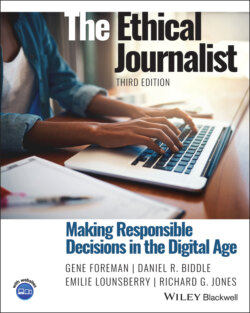Читать книгу The Ethical Journalist - Gene Foreman - Страница 42
Defining ‘Social Responsibility’
ОглавлениеFor more than a century before The Elements of Journalism articulated them, journalism standards had been steadily improving. Underlying this trend was the news media’s growing acceptance of social responsibility – a concept that, in its application to commerce, imposes on business enterprises a moral duty to make their communities better. This is a duty that goes beyond merely obeying laws. Although social responsibility is not discussed here as a religious matter, a principle in Judaism known as tikkun olam seems to define it. Tikkun olam (pronounced tee‐KOON oh‐LUHM) is Hebrew for “repairing the world” – an obligation to fix the problems of society, including violence, disease, poverty, and injustice. 12
In the world of commerce, a company’s acts of social responsibility might involve contributing money and executive time to charities, hiring the disabled, or going beyond legal requirements to prevent pollution. A classic business example is the straightforward way in which Johnson & Johnson responded to the Tylenol tragedy of 1982. Someone tampered with containers of Tylenol on store shelves in Chicago, inserting cyanide that eventually killed seven people. Through the news media, the company immediately warned the public not to buy or use Tylenol until the source of the contamination had been found. Next, Johnson & Johnson recalled every container of the pain reliever. The company did not put the product back on the market until its containers had been made tamper‐proof. A lesser corporate response might have doomed the popular pain reliever, but Tylenol’s sales quickly rebounded. 13
In journalism, Adolph Ochs embraced the idea of social responsibility when he bought The New York Times in 1896 and immediately published a pledge “to give the news impartially, without fear or favor, regardless of party, sect or interests involved.” 14 Eugene Meyer, who bought The Washington Post in 1933, similarly adopted a business plan based on journalistic independence: “In pursuit of the truth, the newspaper shall be prepared to make sacrifices of its material fortunes, if such a course be necessary for public good.” 15
One impetus for social responsibility in the news media was commerce. America’s first newspapers were political organs, but in the 1830s that was changing, “stimulated by industrial growth, the development of larger cities, and technological innovations including steam‐driven printing presses.” Publishers and editors began aiming at a mass market, one in which it made economic sense to report the news neutrally instead of from a party perspective. 16 By the 1880s, the concept of neutral reporting was well established.
By the first half of the twentieth century, journalists’ aspirations for professionalism were growing. Better‐educated people were joining the workforce, and the world’s first journalism school was launched in 1908 at the University of Missouri. 17 Newly formed organizations of journalists quickly adopted codes affirming their responsibility to report the truth and to be fair. The first of these codes was the Canons of Journalism ratified by the new American Society of Newspaper Editors in 1923. 18
